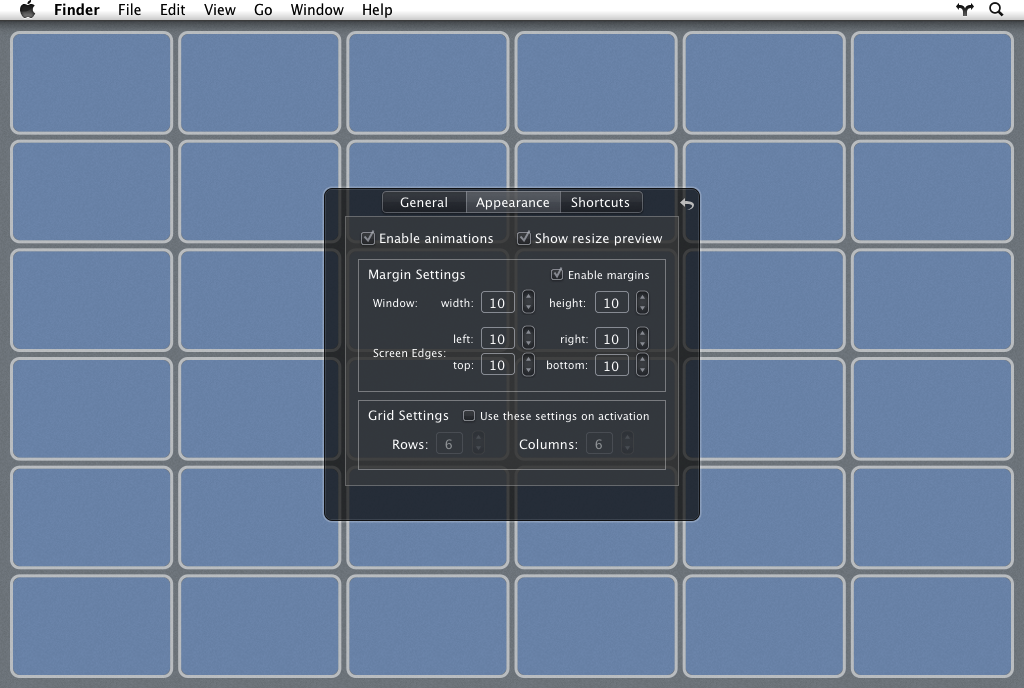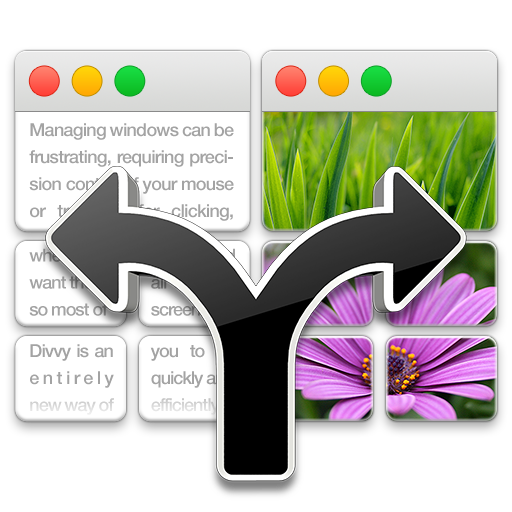
by Mizage
For support, contact support@mizage.com
Table of Contents
Introduction
The Problem
Managing open windows on Mac OS X can be frustrating, requiring precision control of your mouse or trackpad for clicking, dragging, pushing and pulling your windows to the size and position you desire. Even with all this work, it’s very difficult to get windows exactly where you want them, so most of the time windows are left scattered all over the screen.
The Solution
Divvy is an entirely new way of managing your windows. It allows you to quickly and efficiently “divvy up” your screen into exact portions. This lets you take maximum advantage of your screen real estate without any hassle at all. Window management has never been this easy.
With Divvy, it’s as simple as a click & drag in the Divvy interface and your window will be resized and moved to a relative portion of the screen. If that seems like too much work, you can go ahead and create as many different shortcuts as you'd like that resize and move your windows.
Divvy is designed to be quick, simple and elegant, staying out of your way as much as possible while providing the most powerful window management available.
Getting Started
For a quick start introduction to Divvy, watch the short video on our website http://mizage.com
Quick Start Video
Launching Divvy
When Divvy launches, you’ll notice it appear in the menu bar as the forked arrow icon.

Divvy is designed to run in the background at all times so you can quickly and easily access Divvy when you need to manage your windows.
Accessibility
If Divvy requests access to Accessibility, please follow the directions online here: http://mizage.com/help/accessibility.html
The Divvy Interface
Activate the Divvy interface by either:
- Clicking the menu bar icon
- Pressing the user-assigned global keyboard shortcut
- Re-launching the application (only one instance of Divvy runs at a time, so simply launching Divvy again from the Dock, Applications folder, or Spotlight will bring the Divvy panel up for you)
The Divvy interface (aka the Divvy panel) will appear in the center of your screen. If you have more than one screen, a Divvy panel will appear on each of your screens.
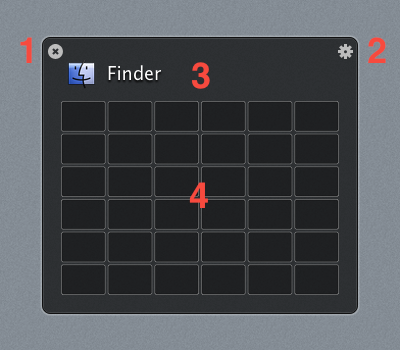
The Divvy panel consists of:
- A button to dismiss the panel
- A button to flip to the Divvy Preferences
- The icon and name of the active application
- The Grid for selecting an area of your screen
Moving Your First Window
Using Divvy is as simple as:
- Click on the window you want to resize
- Activate Divvy
- Use the mouse to click and drag, selecting boxes in the Grid according to where you want the window to be moved and resized on screen
The window will then be moved and resized to fit your screen in proportion to your selection in the Grid and the Divvy panel will automatically dismiss.
For example, if "Keep panel open until dismissed" is disabled and you hold the Shift key while selecting in the Grid, the Divvy panel will stay open so you can resize another window without having to activate Divvy again.
Divvy In-Depth
The Grid
The default 6x6 grid size was chosen because it allows you to put two windows side by side (split screen) or three windows side by side by side. However, we realize you may require more control over the Grid to better utilize your screen real estate, so we have made the Grid easily configurable.
Add or Remove Rows and Columns from the Grid
You can add or remove rows and columns from the Grid on the fly. You can also configure a default grid size that will be shown whenever you activate the Divvy interface or create a new Shortcut (see Appearance Preferences below).
You can add rows and columns up to a maximum of 10x10 (which can be subdivided to 20x20). You can remove rows and columns to a minimum of 1x1 (which is essentially fullscreen).
| Operation | Keyboard Shortcut |
|---|---|
| Add a row | ⌘+ (Cmd + Plus) |
| Remove a row | ⌘- (Cmd + Minus) |
| Add a column | ⇧⌘+ (Cmd + Shift + Plus) |
| Remove a column | ⇧⌘- (Cmd + Shift + Minus) |
Subdivide the Grid
Press the Option key (⌥) to instantly subdivide the grid for finer control over your window placement.
For example, subdivide the default 6x6 grid to get a 12x12 grid. Press the Option key (⌥) key again to revert back.
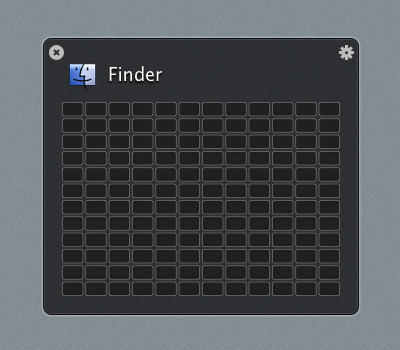
Multiple Screens (Monitors)
Divvy is designed to support your multi-monitor workflow. When you activate Divvy, the Divvy panel will appear on each of your screens. This allows you to move/resize windows on any screen you choose, even if that window isn’t currently on that screen.
Shortcuts
Divvy allows you to create an unlimited number of shortcuts. A shortcut is simply a grid selection and a key combination for quickly applying that grid selection to a window.
There are two types of Divvy shortcuts: Local and Global. Here’s a table to explain the differences:
| Local Shortcut | Global Shortcut |
|---|---|
| Active only when Divvy panel is showing. | Active at all times, in all applications (as long as Divvy is running). |
| Slower to use because you must activate Divvy first. | Quicker to use because the shortcut is always available. |
| Simple. Can be as short as a single character or be combined with modifier keys. No risk of a shortcut colliding with a shortcut used in other applications. | More complex. Must be combined with modifier keys. Each shortcut runs the risk of colliding with shortcuts used in other applications. Care must be taken to prevent collisions, as Divvy cannot detect them. |
Preferences
General Preferences
To access the Divvy General Preferences, activate the Divvy panel, then click the gear button in the upper-right corner of the Divvy panel, then click the “General” tab.
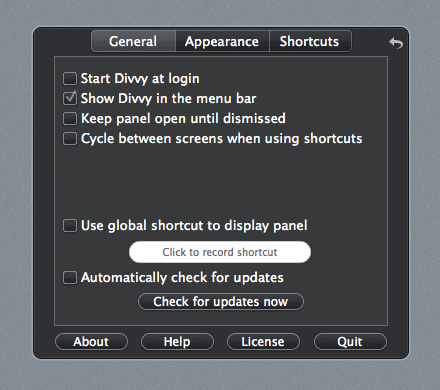
| Setting | Description |
|---|---|
| Start Divvy at login | When enabled Divvy will start automatically whenever you login or restart your computer. Default: disabled |
| Show Divvy in the system tray | Show the Divvy icon in the system tray. If you prefer to access Divvy via the user configurable global keyboard shortcut (see below), you can use this option to disable the system tray icon. Default: enabled |
| Keep panel open until dismissed | By default, the Divvy panel will automatically dismiss after you make a grid selection. If you frequently resize more than one window, try enabling this option to keep the panel open after a grid selection, which might save you some time. To dismiss the Divvy panel, simply press the Esc key, click the close button in the upper-left, or press the global keyboard shortcut (see next option). Default: disabled |
| Cycle between screens when using shortcuts | When enabled, you can press a shortcut multiple times to cycle the window from one screen to the next, through all your screens. This option works for global shortcuts as well as local shortcuts, but local shortcuts require that you also enable the “Keep panel open until dismissed” option. Otherwise, the shortcut will be applied to the screen on which the window currently resides. Default: disabled |
| Use global shortcut to display panel | A user-assignable global keyboard shortcut for displaying and dismissing the Divvy interface. Default: disabled and shortcut unassigned |
| Automatically check for updates | Enable this option to be notified when there’s a new version of Divvy available (recommended). Default: enabled |
Appearance Preferences
To access the Divvy Appearance Preferences, activate the Divvy panel, then click the gear button in the upper-right corner of the Divvy panel, then click the “Appearance” tab.
| Setting | Description |
|---|---|
| Enable animations | Enable this option to see animations in the Divvy interface (not when resizing windows). Default: enabled |
| Show resize preview | As you hover over the Divvy grid, you will see a blue preview square that assists you in the placement of your window. Also, as you drag a selection on the grid, the preview will update to represent where the window will be placed when you finish your selection. Default: enabled |
| Margin Settings | |
| Enable margins | Enable this option to use margins which allows you to control the space around the edges of your screen and between windows. Default: disabled |
| Window (width, height) | Control the space (in pixels) between windows that are resized with Divvy. The live preview allows you to immediately see the effects of your margin settings on the grid. Default: 10 Range: 0-300 |
| Screen Edges (left, right, top, bottom) | Control the space (in pixels) around the screen edges and windows that are resized with Divvy. The live preview allows you to immediately see the effects of your margin settings on the grid. Default: 10 Range: 0-300 |
| Grid Settings | |
| Use these settings on activation Rows & Columns |
Enable this option to force the Divvy grid to always default to the provided Rows and Columns when the Divvy panel is shown. If you add/remove rows & column to the grid on the fly, those changes will be reverted to these Grid settings every time the panel is shown. Default: disabled, 6 & 6 |
Shortcuts Preferences
To access the Divvy Shortcuts Preferences, activate the Divvy panel, then click the gear button in the upper-right corner of the Divvy panel, then click the “Shortcuts” tab.
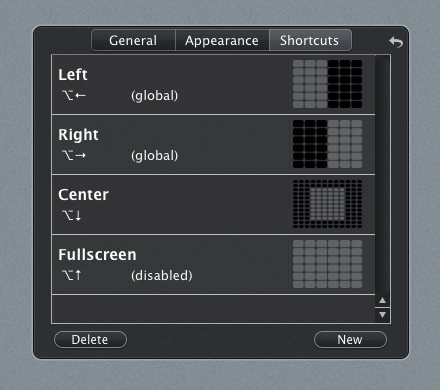
Create a New Shortcut
To create a new shortcut, click the “New” button at the bottom of the Shortcuts Preferences or press ⌘N (Cmd + N) to be presented with a new blank shortcut as seen below:
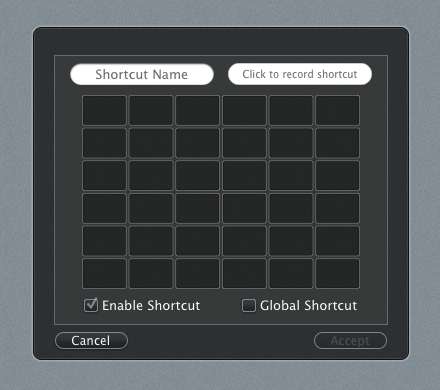
- Start by entering a name for this shortcut, this is used to help you identify the shortcut in the Shortcuts list, but is not required.
- Decide if you want this shortcut to be Local or Global and check the “Global Shortcut” box if needed.
- Enter a keyboard shortcut and Divvy will let you know if there are any obvious conflicts with your choice.
- Adjust the Grid if you want, adding/removing row/columns as desired and/or subdivide the Grid for more precise control.
- Drag out your selection on the Grid.
- Click “Accept” if you’re satisfied with this shortcut or “Cancel” to return to the Shortcut Preferences without creating the shortcut.
Edit a Shortcut
To edit a shortcut, double-click the shortcut in the Shortcuts Preferences. This will present you with a view where you can modify the settings for this shortcut. Click “Accept” if you’re satisfied with this shortcut or “Cancel” to return to the Shortcut Preferences without modifying the shortcut.
Delete a Shortcut
To delete a shortcut, select the shortcut in the Shortcuts Preferences and either click the “Delete” button at the bottom or press ⌘⌫ (Cmd + Delete).
Licensing
- To purchase a license, please visit the Mizage online store at https://store.mizage.com
- For questions relating to what a license covers, see the FAQ at https://store.mizage.com or contact sales@mizage.com
To apply a Divvy license:
- Open the Divvy preferences then click the “License” button at the bottom. This will show the Divvy Registration window.
Note: If you don't see the “License” button then you might be running the version of Divvy from the Mac App Store. - Enter your name in the first field exactly as it appears in the license email.
- Copy & paste your license key into the large box below the name field.
- Click the “Register” button and you will be informed if the process was successful.
Contact support@mizage.com if you require any assistance.
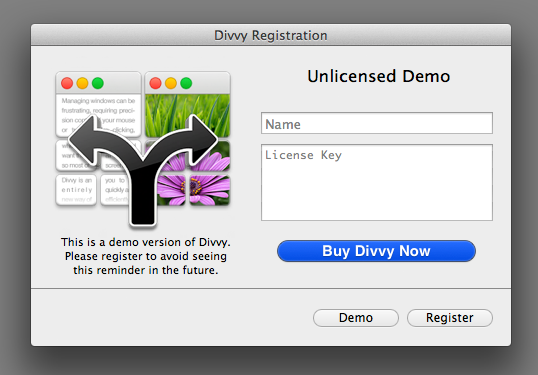
Appendix
Primer on Keyboard Shortcuts
You’re probably used to seeing shortcuts in menus, but they can be a bit cryptic. A keyboard shortcut is a single key (e.g. A, 1, /, F2, etc.) combined with zero or more modifier keys (⌃⌥⇧⌘). Here is a table explaining the modifier keys:
| Modifier Key | Key Name |
|---|---|
| ⌃ | Control or Ctrl |
| ⌥ | Option or Alt |
| ⇧ | Shift |
| ⌘ | Command or Cmd |
So when you see a shortcut like ⌥⌘A, this means to hold the Option key (⌥) and the Cmd key (⌘) then press the A key, then finally, release all keys.
Export/Import Shortcuts
Mac Only: For more information on how to export/import your shortcuts, visit http://mizage.com/help/divvy/export_import.html


